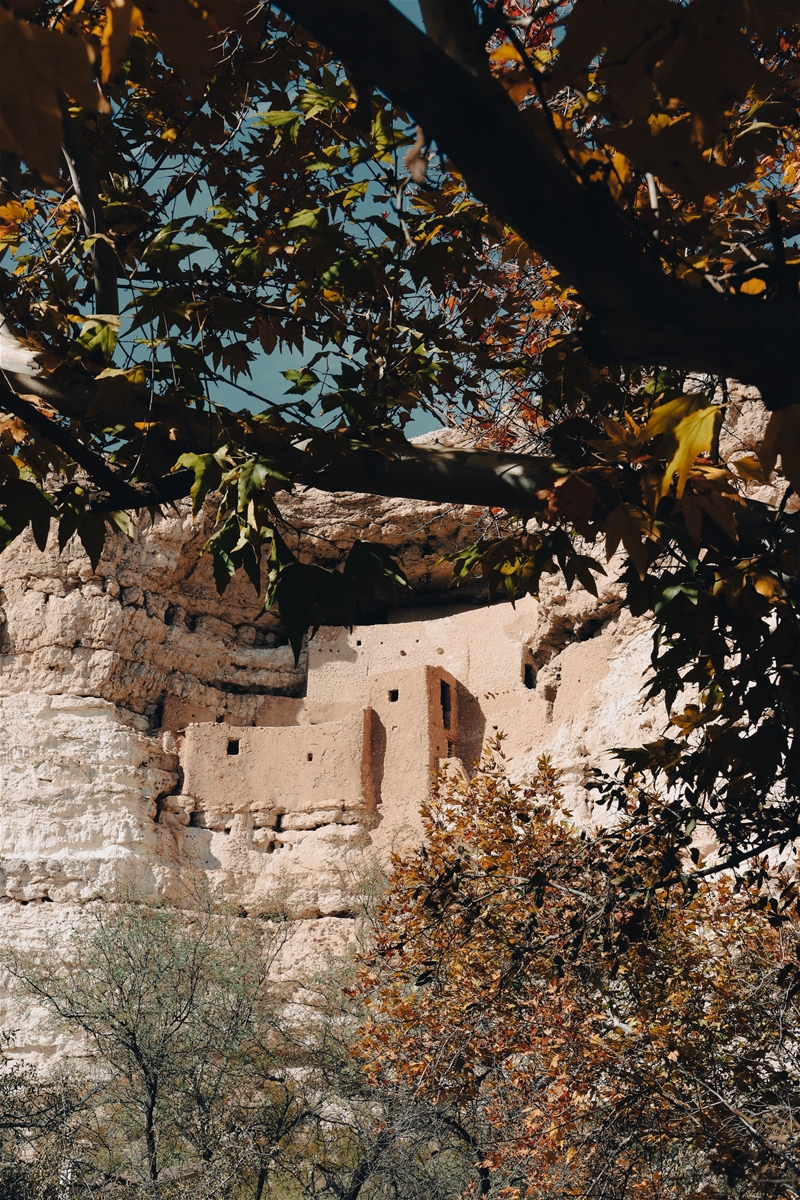The Story of Sedona’s First Settlers
Sedona is visited by over 3 million tourists each year! The attractions are endless – the stunning red rock landscapes surrounding Sedona entice outdoor adventurers of all kinds, luxury spa resorts lure wellness travelers, foodies have a fine selection of restaurants and wineries, and national monuments of timeless beauty give evidence of times gone by.
Sure you can be a sightseer, or you can experience Sedona with a whole new level of adventure and intrigue! According to archaeological evidence, the story of Sedona’s first settlers dates back over 10,000 years with ancient tales ranging from cliff dwellers to cowboys. For the ultimate experience of the history of Sedona’s art, cinema, history, and nature, start your adventure on the Walk Sedona self-guided trail.
Native American Cliff Dwellers
The first known inhabitants were the Paleo, Anasazi, Hohokam, and Sinagua Native American tribes who fished the creeks, farmed corn, beans, squash, and agave on the high desert land, and formed trade routes with other native tribes, some as far as South America. The awe-inspiring surroundings were considered sacred grounds with spiritual rituals, ceremonies, and celebrations a part of everyday life.Around 1100 AD, the Sinaguan people began to construct multi-story dwellings of wood, stone, and mud mortar in the faces of the red rock cliffs to house the influx of families, these were known as pueblos. Most of the pueblos were built along the banks of the Verde River and creeks to provide fertile soil for farming and wildlife for survival.
By 1300 AD, the only evidence of the Sinagua tribe was the petroglyph and pictograph rock art etched in the red rock cave walls. Why they disappeared so suddenly to this day remains a mystery. Soon after, the Yavapai, Apache, Hopi, and Navajo tribes realized the rich local resources and settled happily in the Verde Valley, until the arrival of the European settlers.
Sedona and the Verde Valley are still scattered with some of the oldest and best preserved cliff dwellings in the Southwest, depicting the life of the early settlers to the high-desert region.

Montezuma Castle National Monument
Visit Montezuma CastleMontezuma Castle in Camp Verde is one of the oldest cliff dwellings, constructed by the Sinaguans somewhere around 1100 AD. Set high in a 150-foot limestone cliff, the complex consists of a five story building with a collection of 20 rooms used to house families. Archaeological evidence suggests that Montezuma Castle was also an active trade center for the Sinagua tribe.
Montezuma Well
Visit Montezuma WellLocated six miles upstream, Montezuma Well is a natural limestone sinkhole approximately 55 feet deep and a massive 368 feet wide, with ancient cliff dwellings lining the limestone cliffs. The well is said to have formed between 12,000 to 15,000 years ago by a collapsed cave creating a lush oasis of underwater springs and creeks. Montezuma Well has been an attraction since the late 1800s when tourists were offered boat and fishing tours of the well.
Tuzigoot National Monument
Visit Tuzigoot National MonumentTuzigoot National Monument sits high on a ridge above the Verde Valley, a few miles north of Old Town Cottonwood. Built around 1100 AD, the ancient 110-room Tuzigoot hilltop pueblo is one of the largest of the southern Sinagua villages with a traditional Sinagua-style museum preserving a collection of archeological artifacts from the Verde Valley’s early Native American cave dwellers. Today, visitors can walk in the footsteps of the Sinaguan people on the trails around the Tuzigoot pueblo and Verde River.
Palatki & Honanki Heritage Sites
Visit Palatki Heritage SiteSlightly off the beaten path near Boynton Canyon, the Palatki and Honanki Heritage Sites were the largest cliff dwellings in Arizona’s Red Rock Country. The Palatki site consists of ancient cliff dwellings about two stories high and a nearby grotto with rock art depicting petroglyphs and pictographs from the Sinagua, Yavapai, and Apache tribes along with markings from earlier native tribes, many thousands of years older than the cliff dwellings themselves. Guided group tours of the dwellings and the grotto rock art depart from the Visitor Center every half hour (9:30 AM to 2 PM) daily - reservations are essential as group numbers are limited.
First European Settlers
The first European settlers discovered the Verde Valley in 1583 on an expedition led by Spanish explorer, Antonio de Espejo. The European settlers were on a quest for rich gold and silver mines but after prospecting the region, found only copper. A second expedition in 1598, led by another Spanish explorer, Marcos Farfan de los Godas, yielded the same results.As pioneers, prospectors, and trappers arrived in the 1800s, the peace between the settlers and Native American tribes declined, and by 1875 the Yavapai and Apache people were forcibly removed to a reservation.
Early American Settlers
In 1876, John James Thompson became the first permanent American settler in Sedona, claiming a parcel of land in Oak Creek Canyon under the 1862 Homestead Act. This parcel of land was situated across what is today one of Sedona’s favorite breakfast spots, the Indian Gardens Market & Café. At the same time, John Lee and Henry Schuerman settled along the lower banks of Oak Creek in an area today known as Red Rock State Park.In 1879, the Abraham James family settled just south of Indian Gardens and before long J.J. Thompson married their daughter, Margaret, and together they settled in the Camp Garden community, later named Sedona. Historic records indicate that Abraham James named Sedona’s Bell Rock, Steamboat Rock, Courthouse Rock, and Church Rock, later named Cathedral Rock.
Sedona is Named
By the early 1900s, two dozen families were raising cattle and horses in the area, planting crops along the creek, and before long establishing orchards. In 1901, Theodore C. Schnebly purchased an 80-acre site on Oak Creek and constructed a handsome home that also served as Sedona’s first hotel.As the small local homestead just south of Oak Creek Canyon grew, T.C. Schnebly petitioned for a postal station in the back of his home. After suggesting several names that were rejected by the postmaster, Schnebly’s brother suggested they name it after T.C.’s wife, Sedona. T.C. Schnebly’s home was situated where the Los Abrigados Resort near Tlaquepaque Arts and Crafts Village stands today.
Apple Orchards on Oak Creek
In 1912, Frank Pendley established his first apple orchard on the Pendley family homestead in Oak Creek Canyon, where Slide Rock State Park is situated today. Oak Creek provided easy access to water and Pendley, along with Henry Shuerman and George Jordan constructed an innovative irrigation system to channel the water from Oak Creek to the orchards, a system still in use today.Today, the Sedona Heritage Museum is housed in the original Jordan family farmstead and the Sedona Arts Center is in located in the old Jordan Apple Packing Barn. The historic Pendley apple orchard, homestead, and old cabins may be visited at Slide Rock State Park or visit during apple harvest season (September and October) for apple picking – over 300 trees with 13 different varieties of apples.
Movie Making Era
The red rock scenery of Sedona has provided a stunning backdrop for over 100 feature films, productions, and commercials over the years. The movie making era began in 1923 when Zane Grey’s novel “Call of the Canyon” was adapted into a silent film in Sedona. In 1945, John Wayne produced and starred in the movie “Angel and the Bad Man”, and from thereon, Sedona became Hollywood’s hottest movie set for classics such as “Broken Arrow”, “3:10 to Yuma”, “Easy Rider”, and “Midnight Run” starring Robert De Niro.Today, Sedona is a thriving hub for artists and creatives and many of our streets are named after movies including Broken Arrow, Copper Canyon, Fabulous Texan, Gun Fury, Johnny Guitar, Last Wagon, Pony Soldier, and Station West.
Experience the History of Sedona with Foothills Vacation Rentals
Since 1997, our local team at Foothills Rentals has been creating exceptional experiences for visitors to Sedona. Our hand-picked portfolio of 110+ Sedona and Verde Valley vacation rentals range from cozy 1 bedroom condos to 5 bedroom luxury collection rentals with private pools!However you choose to experience Sedona, you’ll find a home away from home with Foothills Rentals to suit your style, and budget!



.png)
.png)

